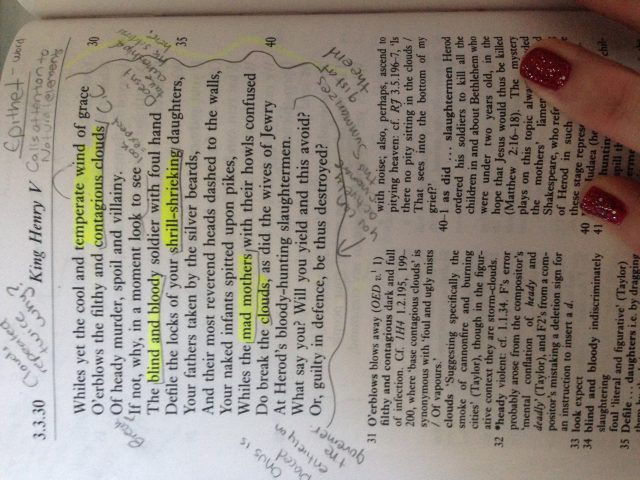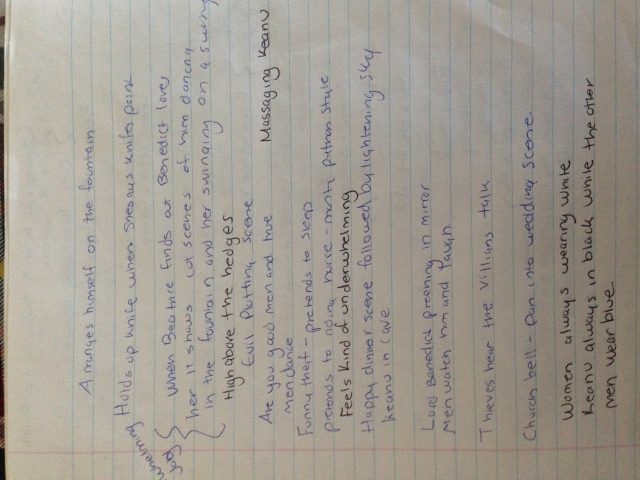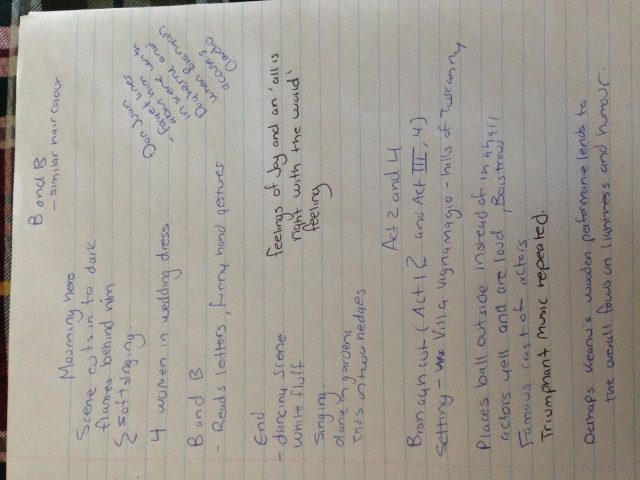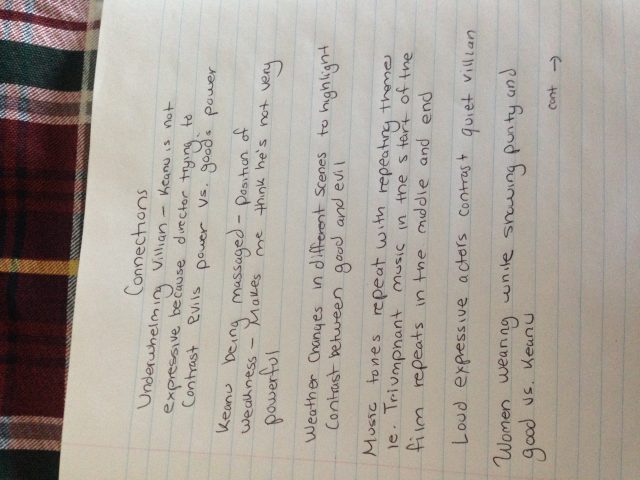Annotating a text and taking notes during a film are a very different process for me. My styles mostly differ in their main objectives. When taking notes during a film, I focus on how the effects make me feel and then connect my ideas to my feelings. When I annotate a text, I focus on a specific argument supported by literary devices. During a film I write down general ideas and overarching feelings, later returning to the film to look for the details that lent to those feelings. As I annotate the text I write down one or two main ideas that I then concentrate on finding evidence for. This blog examines my two note taking styles for film and text and determines their effectiveness.
The first thing I do when annotating a text is read the entire section once without taking notes so I can understand what is going on. I then read the text again and highlight word repetitions while thinking of one or two ideas to provide the focus for my reading. I have taken screenshot examples of my annotations from Henry V where I’ve highlighted the repeated uses of ‘you’, ‘your’ and ‘my’ (Shakespeare 3.3.14-43). I’ve also written a point in the left hand corner outlining my main idea for the passage that Henry wants to remain blameless for the horrors committed by the English soldiers. The third time I read this passage through, I looked for literary devices that would support my idea and found that the repeated use of ‘my’ demonstrated that Henry was claiming ownership of the soldiers. However Henry refers to the soldiers violating the town’s women and butchering the townspeople without the use of the word my, distancing himself from these actions. The repetition of the word ‘your’ places the onus on the townspeople. I defined words such as impious because it supported my argument that Henry was deeming the tragedies as ‘war’s’ fault and not his own(Shakespeare 3.3.14-43).


My annotation style for text focuses on details that support my initial argument. This is beneficial because I can concentrate on supporting my argument but it also means I miss many important components in a passage. I also ignore analyzing elements that don’t support my argument. For instance in the Henry V passage I highlighted alliteration examples that didn’t add to my main point and then I didn’t bother to think about what they meant in the passage. I also chose to believe that the use of natural elements such as wind and clouds was to demonstrate that forces of war are like forces of nature meaning that Henry was attempting to prove he doesn’t have control over the horrors. I didn’t think this was a perfect argument but I wanted to make it fit with my initial idea and I ignored other possibilities. Another problem was that I didn’t look up historical definitions of other words I didn’t know such as ‘licentious’ and ‘reverend’ because I didn’t think they would support my idea.
While I miss details and pigeonhole myself with one argument in text annotation, my annotation style does allow me to make a succinct argument supported by detailed evidence. However I am much more effective in doing this when I take notes for a film even though the process takes longer. In this screenshot of my notes taken while I watched Kenneth Branagh’s, Much Ado about Nothing, I have written down ostensibly disconnected notes about every scene. These notes include observations about costumes, musical selections, facial expressions and my feelings during each scene. I had no argument to support and I just wrote down everything I observed. This may seem less conducive to making a good argument but after I did this I watched the film again and on a separate list I wrote down the connections between the different components and how I felt during the scenes. Although it was a longer process, it was more effective as I didn’t miss details just because they didn’t support an initial argument. I was able to form many conclusions as opposed to one and then easily connect them together.



My annotating style for text allows me to find a significant amount of evidence to support my arguments but I often miss important elements because I’m too focused on one idea. Alternatively my note taking style for films allows me to capture the overarching ideas but the downside is that I miss many of the details unless I watch the film several times. My style for film however is a more effective approach as it allows me to successfully develop a well thought out argument whereas my text annotations limit me to one idea.
Works Cited
Shakespeare, William. King Henry V. Ed. T.W.Craik Routledge, 1995. Rpt.Bloomsbury Arden Shakespeare, 2009,2011,2012,2013,2014,2015 Print.
By Jennifer Pelham
Leave a Reply
You must be logged in to post a comment.